The Human Pyramids of Abu Ghraib-Part I
On April 28th, 2004, CBS broadcast a segment on the Abu Ghraib prison on its program 60 Minutes II.
(CBS News)
According to the U.S. Army, one Iraqi prisoner was told to stand on a box with his head covered, wires attached to his hands. He was told that if he fell off the box, he would be electrocuted.
It was this picture, and dozens of others, that prompted an investigation by the U.S. Army. On Tuesday, 60 Minutes II asked Brig. Gen. Mark Kimmitt, deputy director of coalition operations in Iraq, what went wrong.
“Frankly, I think all of us are disappointed by the actions of the few,” says Kimmitt. “Every day, we love our soldiers, but frankly, some days we're not always proud of our soldiers."
For decades under Saddam Hussein, many prisoners who were taken to the Abu Ghraib prison never came out. It was the centerpiece of Saddam’s empire of fear, and those prisoners who did make it out told nightmarish tales of torture beyond imagining – and executions without reason.
60 Minutes II talked about the prison and shared pictures of what Americans did there with two men who have extensive interrogation experience: Former Marine Lt. Col. Bill Cowan and former CIA Bureau Chief Bob Baer.
"I visited Abu Ghraib a couple of days after it was liberated. It was the most awful sight I've ever seen. I said, ‘If there's ever a reason to get rid of Saddam Hussein, it's because of Abu Ghraib,'” says Baer. “There were bodies that were eaten by dogs, torture. You know, electrodes coming out of the walls. It was an awful place."
"We went into Iraq to stop things like this from happening, and indeed, here they are happening under our tutelage,” says Cowan.It was American soldiers serving as military police at Abu Ghraib who took these pictures. The investigation started when one soldier got them from a friend, and gave them to his commanders. 60 Minutes II has a dozen of these pictures, and there are many more – pictures that show Americans, men and women in military uniforms, posing with naked Iraqi prisoners.
There are shots of the prisoners stacked in a pyramid, one with a slur written on his skin in English.
In some, the male prisoners are positioned to simulate sex with each other. And in most of the pictures, the Americans are laughing, posing, pointing, or giving the camera a thumbs-up.
60 Minutes II was only able to contact one of the soldiers facing charges. But the Army says they are all in Iraq, awaiting court martial.
"What can the Army say specifically to Iraqis and others who are going to see this and take it personally," Rather asked Kimmitt, in an interview conducted by satellite from Baghdad.
"The first thing I’d say is we’re appalled as well. These are our fellow soldiers. These are the people we work with every day, and they represent us. They wear the same uniform as us, and they let their fellow soldiers down,” says Kimmitt.
“Our soldiers could be taken prisoner as well. And we expect our soldiers to be treated well by the adversary, by the enemy. And if we can't hold ourselves up as an example of how to treat people with dignity and respect … We can't ask that other nations to that to our soldiers as well."
“So what would I tell the people of Iraq? This is wrong. This is reprehensible. But this is not representative of the 150,000 soldiers that are over here,” adds Kimmitt. “I'd say the same thing to the American people... Don't judge your army based on the actions of a few."One of the soldiers facing court martial is Army Reserve Staff Sgt. Chip Frederick.
Army Reserve Staff Sgt. Ivan 'Chip' FrederickFrederick is charged with maltreatment for allegedly participating in and setting up a photo, and for posing in a photograph by sitting on top of a detainee. He is charged with an indecent act for observing one scene. He is also charged with assault for allegedly striking detainees – and ordering detainees to strike each other.
60 Minutes II talked with him by phone from Baghdad, where he is awaiting court martial.
Frederick told us he will plead not guilty, claiming the way the Army was running the prison led to the abuse of prisoners.
“We had no support, no training whatsoever. And I kept asking my chain of command for certain things...like rules and regulations,” says Frederick. “And it just wasn't happening."
Six months before he faced a court martial, Frederick sent home a video diary of his trip across the country. Frederick, a reservist, said he was proud to serve in Iraq. He seemed particularly well-suited for the job at Abu Ghraib. He’s a corrections officer at a Virginia prison, whose warden described Frederick to us as “one of the best.”
Frederick says Americans came into the prison: “We had military intelligence, we had all kinds of other government agencies, FBI, CIA ... All those that I didn't even know or recognize."
Frederick's letters and email messages home also offer clues to problems at the prison. He wrote that he was helping the interrogators:
"Military intelligence has encouraged and told us 'Great job.' "
"They usually don't allow others to watch them interrogate. But since they like the way I run the prison, they have made an exception."
"We help getting them to talk with the way we handle them. ... We've had a very high rate with our style of getting them to break. They usually end up breaking within hours."According to the Army’s own investigation, that’s what was happening. The Army found that interrogators asked reservists working in the prison to prepare the Iraqi detainees, physically and mentally, for questioning.
What, if any actions, are being taken against the interrogators?
"I hope the investigation is including not only the people who committed the crimes, but some of the people that might have encouraged these crimes as well,” says Kimmitt. “Because they certainly share some level of responsibility as well."
But so far, none of the interrogators at Abu Ghraib are facing criminal charges. In fact, a number of them are civilians, and military law doesn’t apply to them.
One of the civilian interrogators at Abu Ghraib was questioned by the Army, and he told investigators he had "broken several tables during interrogations, unintentionally," while trying to "fear up" prisoners. He denied hurting anyone.
In our phone conversation, 60 Minutes II asked Frederick whether he had seen any prisoners beaten.
“I saw things. We had to use force sometimes to get the inmates to cooperate, just like our rules of engagement said,” says Frederick. “We learned a little bit of Arabic, basic commands. And they didn't want to listen, so sometimes, you would just give them a little nudge or something like that just to get them to cooperate so we could get the mission accomplished."
Attorney Gary Myers and a judge advocate in Iraq are defending Frederick. They say he should never have been charged, because of the failure of his commanders to provide proper training and standards.
"The elixir of power, the elixir of believing that you're helping the CIA, for God's sake, when you're from a small town in Virginia, that's intoxicating,” says Myers. “And so, good guys sometimes do things believing that they are being of assistance and helping a just cause. ... And helping people they view as important."
Frederick says he didn't see a copy of the Geneva Convention rules for handling prisoners of war until after he was charged.
The Army investigation confirms that soldiers at Abu Ghraib were not trained at all in Geneva Convention rules. And most were reservists, part-time soldiers who didn't get the kind of specialized prisoner of war training given to regular Army members.
Frederick also says there were far too few soldiers there for the number of prisoners: “There was, when I left, there was over 900. And there was only five soldiers, plus two non-commissioned officers, in charge for those 900 -- over 900 inmates."
Rather asked Kimmitt about understaffing. "That doesn't condone individual acts of criminal behavior no matter how tired we are. No matter how stretched we are, that doesn't give us license and it doesn't give us the authority to break the law,” says Kimmitt.
“That may have been a contributing factor, but at the end of the day, this is probably more about leadership, supervision, setting standards, abiding by the Army values and understanding what's right, and having the guts to say what's right.”Brig. Gen. Janice Karpinsky ran Abu Ghraib for the Army. She was also in charge of three other Army prison facilities that housed thousands of Iraqi inmates.
The Army investigation determined that her lack of leadership and clear standards led to problems system wide. Karpinski talked with 60 Minutes’ Steve Kroft last October at Abu Ghraib, before any of this came out.
"This is international standards,” said Karpinski. “It's the best care available in a prison facility."
Brig. Gen. Janice KarpinskiBut the Army investigation found serious problems behind the scenes. The Army has photographs that show a detainee with wires attached to his genitals. Another shows a dog attacking an Iraqi prisoner. Frederick said that dogs were “used for intimidation factors.”
Part of the Army's own investigation is a statement from an Iraqi detainee who charges a translator - hired to work at the prison - with raping a male juvenile prisoner: "They covered all the doors with sheets. I heard the screaming. ...and the female soldier was taking pictures."
There is also a picture of an Iraqi man who appears to be dead -- and badly beaten.
"It's reprehensible that anybody would be taking a picture of that situation,” says Kimmitt.
But what about the situation itself?
“I don't know the facts surrounding what caused the bruising and the bleeding,” says Kimmitt. “If that is also one of the charges being brought against the soldiers, that too is absolutely unacceptable and completely outside of what we expect of our soldiers and our guards at the prisons."
Is there any indication that similar actions may have happened at other prisons? “I'd like to sit here and say that these are the only prisoner abuse cases that we're aware of, but we know that there have been some other ones since we've been here in Iraq,” says Kimmitt.
On July 20, 2003, U.S. Deputy Secretary of Defense Paul Wolfowitz
tours Abu Ghraib prison, accompanied by U.S. Brig Gen. Janice Karpinski
U.S. Secretary of Defense Donald Rumsfeld with Brig. Gen. Janice KarpinksiWhen Saddam ran Abu Ghraib prison, Iraqis were too afraid to come ask for information on their family members.
When 60 Minutes II was there last month, hundreds had gathered outside the gates, worried about what is going on inside.
"We will be paid back for this. These people at some point will be let out,” says Cowan. “Their families are gonna know. Their friends are gonna know."
This is a hard story to have to tell when Americans are fighting and dying in Iraq. And for Cowan, it’s a personal issue. His son is an infantry soldier serving in Iraq for the last four months.
Rather asked Cowan what he would say to "that person who is sitting in their living room and saying, ‘I wish they wouldn't do this. It's undermining our troops and they shouldn't do it.’"
"If we don't tell this story, these kinds of things will continue. And we'll end up getting paid back 100 or 1,000 times over,” says Cowan. “Americans want to be proud of each and everything that our servicemen and women do in Iraq. We wanna be proud. We know they're working hard. None of us, now, later, before or during this conflict, should wanna let incidents like this just pass."
Kimmitt says the Army will not let what happened at Abu Ghraib just pass. What does he think is the most important thing for Americans to know about what has happened?
"I think two things. No. 1, this is a small minority of the military, and No. 2, they need to understand that is not the Army,” says Kimmitt. “The Army is a values-based organization. We live by our values. Some of our soldiers every day die by our values, and these acts that you see in these pictures may reflect the actions of individuals, but by God, it doesn't reflect my army."
Two weeks ago, 60 Minutes II received an appeal from the Defense Department, and eventually from the Chairman of the Joint Chiefs of Staff, Gen. Richard Myers, to delay this broadcast -- given the danger and tension on the ground in Iraq.
60 Minutes II decided to honor that request, while pressing for the Defense Department to add its perspective to the incidents at Abu Ghraib prison. This week, with the photos beginning to circulate elsewhere, and with other journalists about to publish their versions of the story, the Defense Department agreed to cooperate in our report.
(sftt.org) SFTT Role in Uncovering Abu Ghraib Abuses. May 12, 2004.
SFTT's website provided the conduit for the key contact when William Lawson, the uncle of one on the MP's facing charges, and a retired USAF Master Sergeant, contacted Roger Charles who was working as a consultant with 60 Minutes II. Roger had placed a request for information about the involuntary discharge of four Reservists from the 320th MP Battalion on the SFTT web site. An automatic response link went straight to Charles.
Information provided by Lawson and follow-up contacts allowed the CBS production team to develop additional information about the 372nd MP Company, the 320th MP Battalion and the 800th MP Brigade. The subsequent intensive investigation produced the 60 Minutes II program seen on April 28 that exposed the abuses at Abu Ghraib, including the now historical photographs.
It should be noted that 60 Minutes II had been working on this story for over a month prior to Lawson's initial contact via the SFTT web site. CBS had received a tip from a source in Kuwait in February, but the information was too general for quick exploitation. Two 60 Minutes II producers traveled to Kuwait in March and obtained more details from this source, but the CBS investigation remained stalled until Lawson turned to David Hackworth's SFTT website and made contact with Charles and the 60 Minutes II team.
This Iraqi prisoner had electrical wires wrapped around his arms, his legs,
and his testicles.
He was told that if he stepped off the box, that he would be electrocuted.
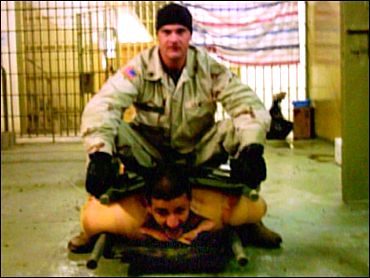
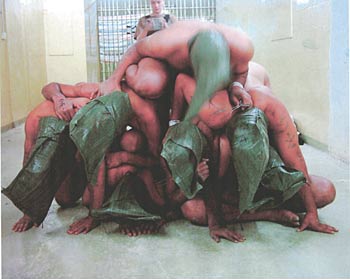
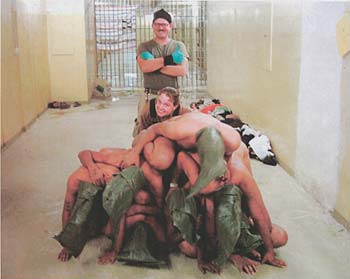
Iraqi prisoners were forced to get up on one of another in a pyramid, with
bags over their heads.
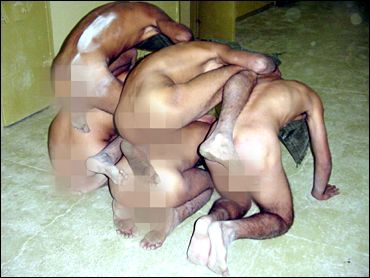
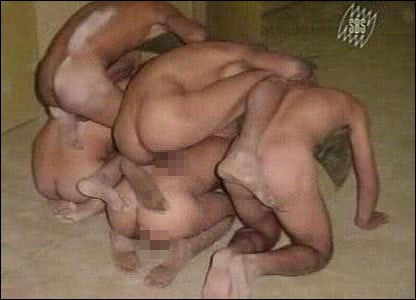
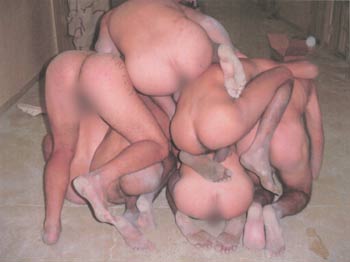
The human pyramid
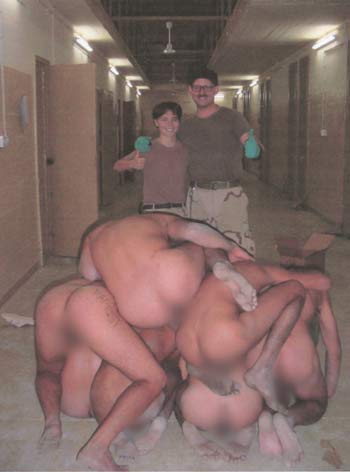
The smiles and the thumbs-up gesture
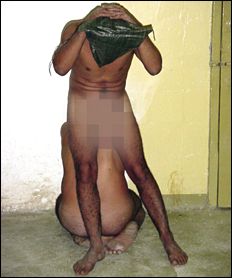
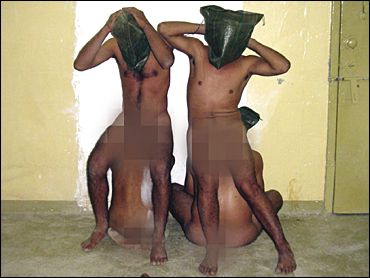
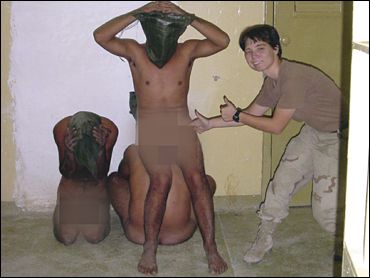
A big, wide smile on
Lynndie England's face as she does a thumbs-up
and points at the exposed genitals of the Iraq man
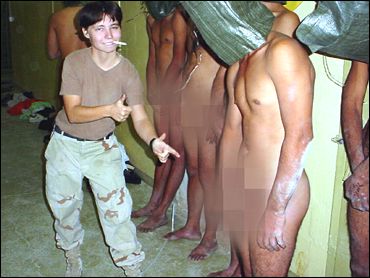
Lynndie England with a cigarette dangling from
her mouth giving a thumbs-up sign
while pointing at the genitals of a naked and hooded young Iraqi
who has been ordered to masturbate
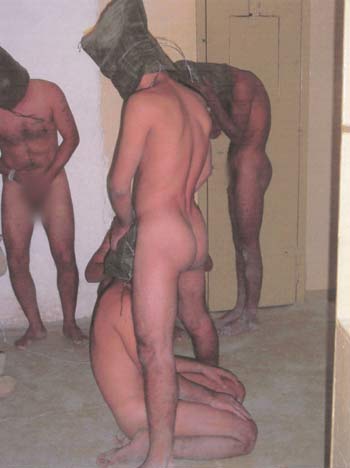
They were forced to do oral sex on each other at gunpoint.
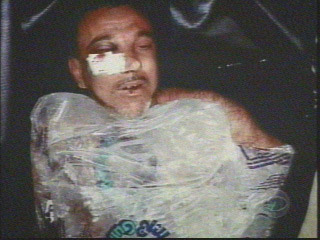
Manadel al-Jamadi
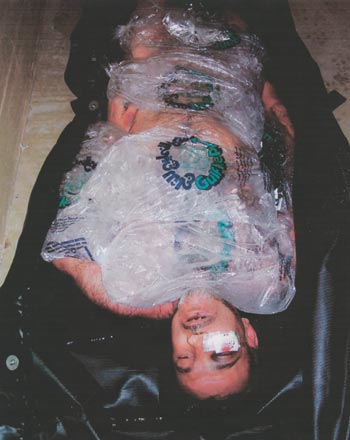
A soldier unzipped a body bag to take a photo
of the traumatized detainee
Manadel al-Jamadi's frozen corpse inside.
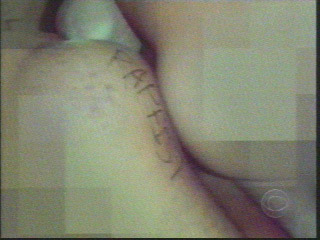
The letters "I am a rapeist" were written on the body of a detainee
(Columbia Journlism Review) Tortured Logic. By Christopher Hanson. July/August issue.
News editors often say that drawing fire from right and left is proof a news outfit has done a good job. CBS News recently put that homily to the test.
At the Pentagon’s behest, the network sat on exclusive, shocking photographic evidence that American military guards had been abusing Iraqi inmates. Then, after holding the piece for two weeks, CBS reversed course and ran it on the April 28 60 Minutes II, when Dan Rather disclosed the delay.
CBS was quickly under attack for subverting the war effort by running the story. So, lest viewers question the network’s patriotism, the CBS News executive Jim Murphy declared on CNN’s May 16 Reliable Sources, “You know what? We are like every other American. We want to win this war. We believe in the country.”
The network simultaneously faced the accusation of being a tool of the war machine because it had held the story. So, lest viewers question the network’s independence, the CBS News executive Jeffery Fager told the Baltimore Sun that his news team had held the story out of concern for the safety of hostages, not to carry water for the Pentagon. Other critics said CBS had cynically reversed itself for the sake of a scoop and ratings. The network’s defense was that it had become unrealistic to keep a lid on the photos when it learned that The New Yorker was about to run them.
In short, CBS justified holding the piece on humanitarian grounds and in the same breath justified airing it for reasons of expediency. That position might seem brash, but is it defensible? Consider the pro-CBS arguments advanced by various groups:
- News outlets had already reported that the Army was investigating charges of prisoner abuse. The photos were more like a follow-up story, so delaying their release was no big deal.
This was a favorite with talk-show-circuit conservatives, but they failed to see that the photographs were the story, as The Sacramento Bee’s ombudsman put it. Taken by perpetrators themselves, these digital pictures transformed a sketchy, abstract page A20 filler story into a page-one story that conveyed horror in unforgettable images: prisoners stripped naked, stacked in human pyramids, hooded, and threatened with electrocution. As Defense Secretary Donald Rumsfeld himself testified before a Senate subcommittee, “It is the photographs that give one the vivid realization of what actually took place. Words don’t do it.”
The photos raised substantial doubts about President Bush’s claim that American troops were in Iraq as benign liberators. Before the photo scandal, Bush had not addressed the prisoner issue; now he apologized for the mistreatment of Iraqi inmates and vowed the military prisons in Iraq would be transformed.
- CBS was merely delaying the report. Since abuse of Iraqis in Baghdad’s Abu Ghraib prison had already been stopped, there was no need to rush to the air.
In fact, there were strong reasons for getting the report out immediately. Because the photos were so disturbing, their release would probably have led quickly to congressional investigations, making it harder for higher-ups implicated in the abuses to cover their tracks.
A second point: the military was holding “war on terror” prisoners, who could have been suffering similar or worse abuse, in secret locations around the world. The photo report might well have led to probes of those other prisons.
Third, one hates to be suspicious, but isn’t it possible some military brass wanted the photos held to avoid political embarrassment for as long as possible? There was a risk that the heads of flag officers, and not just lowly soldiers, would roll if the sordid details of the scandal became public.
In hearings after the story broke, even a few Senate Republicans reprimanded General Richard Myers for trying to cover up a scandal by personally asking Dan Rather not to run the piece. Myers had told Rather the photos would increase tensions in Iraq. But under questioning, the Joint Chiefs chairman admitted he had not even seen the photos when he asked CBS to sit on them.
That makes one wonder how thoroughly CBS probed his reasoning before agreeing to self-censorship. Perhaps the main lesson from this whole affair is to ask very skeptical questions and get detailed, satisfactory answers before acceding to any such request. That should hardly be a rash policy, even in time of war.
At any rate, by the Pentagon’s logic, there might never have been an appropriate time to release the report, at least not while U.S. forces remained in Iraq. In early June, for instance, a UN-sanctioned interim government was appointed. Releasing the photos at that point would have run the risk of stirring up insurrectionists and undermining the new government. The same could be said for the period leading up to the new Iraq’s democratic elections, scheduled for January 2005.
- CBS needed to hold the story to avoid retaliation against Western hostages, especially two Americans. But once it became clear that The New Yorker was determined to publish its own photos, the magazine became solely responsible for the captives’ fate and CBS was free to run its report with a clear conscience.
This chain of reasoning is hard to credit, considering that the network rushed in and released the story first — on a prime-time show that had far more reach and impact than The New Yorker, and presumably more power to do damage. Of course, if CBS had acknowledged having that power, it would have been conceding, tacitly at least, that it valued the scoop above all. And even that it might be partly responsible for the death of the U.S. hostage Nicholas Berg, whose beheaded body was found ten days after CBS released its story— in revenge, the terrorists said, for the abuses revealed in the photos.
All things considered, it would have made more sense for CBS to reject at the outset the Pentagon’s premise that journalists had much responsibility for the hostages. Berg’s killers, for instance, were ruthless enough to release a propaganda video that showed them sawing his head off as he screamed in terror and agony. Is it likely that a group so steeped in hate would ever have released the young man alive?
Of course, if General Myers had told Dan Rather that Delta Force had located Berg and was about to launch a rescue attempt, it would have made sense to delay the story. Otherwise, CBS should have stuck to its primary job — putting out the news.
Not that this was an easy decision. CBS faced what ethicists at the Poynter Institute would call a classic moral quandary, pitting the network’s obligation to report the truth against the duty to minimize the harm its reporting would cause. In such a pickle, the conventional approach is to try avoiding both horns of the dilemma, and, failing that, to take the hit from the less damaging horn in order to perform at least part of one’s journalistic duty well.
But CBS took a decidedly unconventional route. First, it put aside its obligation to report news in a timely fashion out of concern for human lives. Then it briefly put aside the concern for human lives in order to report news in a timely fashion. It got its exclusive.
In other words, the network gored itself on both horns of the ethical dilemma. That was quite an accomplishment.
(Washington Post) New Prison Images Emerge: Graphic Photos May Be More Evidence of Abuse, by Christian Davenport, May 6, 2004.
The collection of photographs begins like a travelogue from Iraq. Here are U.S. soldiers posing in front of a mosque. Here is a soldier riding a camel in the desert. And then: a soldier holding a leash tied around a man's neck in an Iraqi prison. He is naked, grimacing and lying on the floor.
Mixed in with more than 1,000 digital pictures obtained by The Washington Post are photographs of naked men, apparently prisoners, sprawled on top of one another while soldiers stand around them.
There is another photograph of a naked man with a dark hood over his head, handcuffed to a cell door. And another of a naked man handcuffed to a bunk bed, his arms splayed so wide that his back is arched. A pair of women's underwear covers his head and face.
The graphic images, passed around among military police who served at the Abu Ghraib prison in Baghdad, are a new batch of photographs similar to those broadcast a week ago on CBS's "60 Minutes II" and published by the New Yorker magazine. They appear to provide further visual evidence of the chaos and unprofessionalism at the prison detailed in a report by Army Maj. Gen. Antonio M. Taguba. His report, which relied in part on the photographs, found "numerous incidents of sadistic, blatant, and wanton criminal abuses" that were inflicted on detainees.
This group of photographs, taken from the summer of 2003 through the winter, ranges widely, from mundane images of everyday military life to pictures showing crude simulations of sex among soldiers. The new pictures appear to show American soldiers abusing prisoners, many of whom wear ID bands, but The Post could not eliminate the possibility that some of them were staged.
The photographs were taken by several digital cameras and loaded onto compact discs, which circulated among soldiers in the 372nd Military Police Company, an Army Reserve unit based in Cresaptown, Md. The pictures were among those seized by military investigators probing conditions at the prison, a source close to the unit said.
The investigation has led to charges being filed against six soldiers from the 372nd. "The allegations of abuse were substantiated by detailed witness statements and the discovery of extremely graphic photographic evidence," Taguba's report states.
For many units serving in Iraq, digital cameras are pervasive and yet another example of how technology has transformed the way troops communicate with relatives back home. From Basra to Baghdad, they e-mail pictures home. Some soldiers, including those in the 372nd, even packed video cameras along with their rifles and Kevlar helmets.
Bill Lawson, whose nephew, Staff Sgt. Ivan L. "Chip" Frederick, is one of the soldiers charged in the incident, said that Frederick sent home pictures from Iraq on a few occasions. They were "just ordinary photos, like a tourist would take" and nothing showing prisoner abuse, he said.
"I would say that's something that's very common that's going on in Iraq because it's so convenient and easy to do," Lawson said of troops sending pictures home. He added that his nephew also mailed videocassettes "of him talking into a camcorder to [his wife] when he was going on his rounds."
But in the case of prisoner abuse, the ubiquity of digital cameras has created a far more combustible international scandal that would have been sparked only by the release of Taguba's searing written report. Since the "60 Minutes II" broadcast, pictures of abuse have been posted on the Internet and shown on television stations worldwide.
The photographs have been condemned by U.S. military commanders, President Bush and leaders around the world. They have sparked particularly strong indignation in the Middle East, where many people see them as reinforcing the notion "that the situation in Iraq is one of occupation," said Shibley Telhami, who holds the Anwar Sadat Chair for Peace and Development at the University of Maryland.
The impact is heightened by religion and culture. Arabs "are even more offended when the issue has to do with nudity and sexuality," he said. "The bottom line here is these are pictures of utter humiliation."
It is unclear who took the photographs, or why.
Lawyers representing two of the accused soldiers, and some soldiers' relatives, have said the pictures were ordered up by military intelligence officials who were trying to humiliate the detainees and coerce other prisoners into cooperating.
"It is clear that the intelligence community dictated that these photographs be taken," said Guy L. Womack, a Houston lawyer representing Spec. Charles A. Graner Jr., 35, one of the soldiers charged.
The father of another soldier facing charges, Spec. Jeremy C. Sivits of Hyndman, Pa., also said his son was following orders. "He was asked to take pictures, and he did what he was told," Daniel Sivits said in a telephone interview last week.
Military spokesmen at the U.S. Central Command in Qatar and at the Combined Joint Task Force 7 headquarters in Baghdad referred requests for comment about those claims to Col. Jill Morgenthaler, a U.S. military spokeswoman. Morgenthaler could not be reached by telephone yesterday and did not return requests to comment by e-mail. Requests to speak with Col. Thomas M. Pappas -- who commands the 205th Military Intelligence Brigade, based in Germany, and whose troops were stationed at Abu Ghraib -- were declined by a U.S. military spokesman for the Army's V Corps in Heidelberg, Germany.
Yesterday, in Fort Ashby, W.Va., two siblings and a friend identified Pfc. Lynndie England, 21, as the soldier appearing in a picture holding a leash tied to the neck of a man on the floor. England, a member of the 372nd, has also been identified in published reports as one of the soldiers in the earlier set of pictures that were made public, which her relatives also confirmed yesterday. England has been reassigned to Fort Bragg, N.C., her family said. Attempts to reach her were unsuccessful. The military has not charged her in the case.
England's friends and relatives said the photographs must have been staged. "It just makes me laugh, because that's not Lynn," said Destiny Goin, 21, a friend. "She wouldn't pull a dog by its neck, let alone drag a human across a floor."
England worked as a clerk in the unit, processing prisoners before they were put in cells, taking their names, fingerprinting them and giving them identification numbers, her family said. Other soldiers would ask her to pose for photographs, said her father, Kenneth England. "That's how it happened," he said.
Soon after CBS aired its photographs, Terrie England said she received a call from her daughter.
" 'Mom,' she told me, 'I was in the wrong place at the wrong time,' " Terrie England said.
The pictures obtained by The Post include shots of soldiers simulating sexually explicit acts with one another and shots of a cow being skinned and gutted and soldiers posing with its severed head. There are also dozens of pictures of a cat's severed head.
Other photographs show wounded men and corpses. In one, a dead man is lying in the back of a truck, his shirt, face and left arm covered in blood. His right arm is missing. Another photograph shows a body, gray and decomposing. A young soldier is leaning over the corpse, smiling broadly and giving the "thumbs-up" sign.
And in another picture a young woman lifts her shirt, exposing her breasts. She is wearing a white band with numbers on her wrist, but it is unclear whether she is a prisoner.
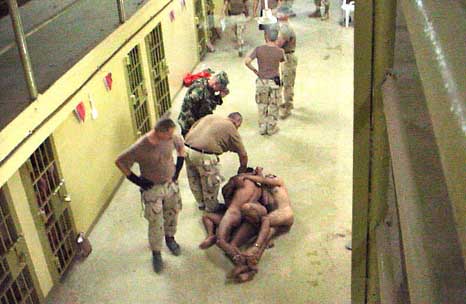
Washington Post
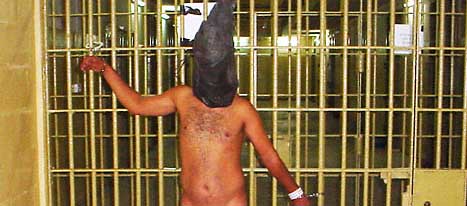
Washington Post
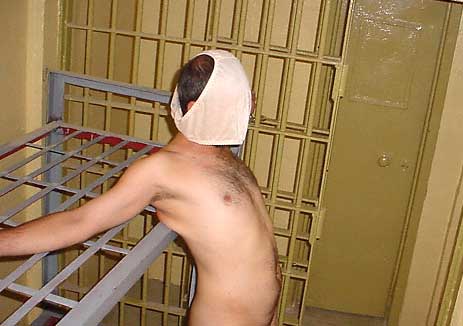
Washington Post

Lynndie England, from the Washington Post
(Washington Post) 'I Simply Stood With The Strap in My Hand' May 22, 2004.
Judging from the photo itself, it is unclear whether England is dragging the grimacing, naked prisoner across the floor, or if she is just standing there holding the leash around his neck.
According to the statement she gave investigators, it is the latter -- and it was not her idea.
England, whose family said she processed inmates but did not work inside the cellblock, said she visited a wing where many prisoners were held. Only two soldiers were on duty, Graner and Spec. Megan Ambuhl.
They had mentioned that there was a detainee named Gus in solitary confinement, England said. He had been arrested for "attacks on coalition forces," she said, and had told other soldiers that he "hated Americans and wanted to kill us."
Graner had suggested taking a picture of the detainee, and he wanted England to pose, "pretending to drag him on a leash-type thing," she said.
Graner got out the leash, and they went down to a solitary confinement cell where the detainee was being held, she said. The detainee emerged naked but not handcuffed. And after Graner made him lie down on the floor, she said, he loosely looped the strap around his neck and handed it to her.
Then he got out his camera, she posed and he snapped a photo.
"I did not drag or pull on the leash," she said. "I simply stood with the strap in my hand. Gus started to crawl on the floor and . . . Graner took another picture. We then took the strap off of him and placed him back in his cell."
All this time, she said, Ambuhl stood and watched.
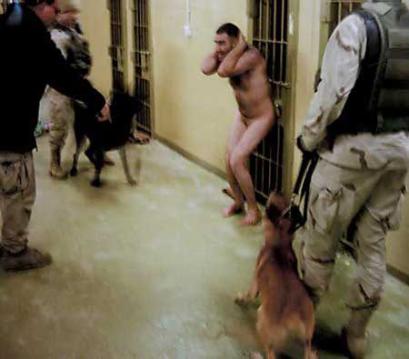
The New Yorker
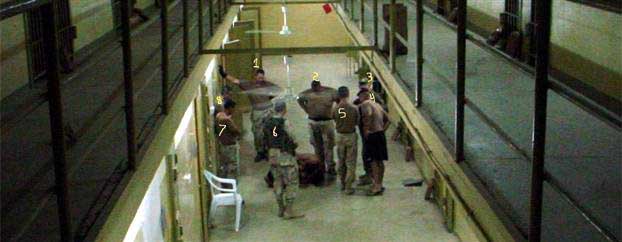
Supplied by Guy Womack
(ABC News) May 19, 2004.
ABCNEWS has obtained two new photos taken at the Abu Ghraib prison in Iraq showing Spc. Charles Graner and Spc. Sabrina Harman posing over the body of a detainee who was allegedly beaten to death by CIA or civilian interrogators in the prison's showers. The detainee's name was Manadel al-Jamadi.
According to testimony from Spc. Jason Kenner, obtained by ABCNEWS, the man was brought to the prison by U.S. Navy Seals in good health. Kenner said he saw extensive bruising on the detainee's body when he was brought out of the showers, dead. Kenner says the body was packed in ice during a "battle" between CIA and military interrogators over who should dispose of the body.
The photos were taken by Staff Sgt. Ivan "Chip" Frederick, who in e-mails to his family has asked why the people responsible for the prisoner's death were not being prosecuted in the same manner that he is. Frederick, Graner, and Harman are among six reservists from the 372nd Military Police Company who are facing charges in the abuse scandal.
A lawyer for Graner, Guy Womack, told ABCNEWS the photo of his client represents inappropriate "gallows humor." Womack questioned why U.S. officials have not opened a criminal investigation into alleged murders at Abu Ghraib, while the investigation of his client has proceeded at a rapid pace.
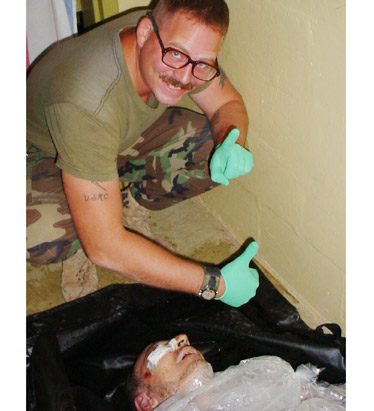
Spc. Charles Graner over the body of Manadel
al-Jamadi

Spc. Sabrina Harman over the body of Manadel
al-Jamadi
BBC published two following two photos with credit to AP/ABC News. The face of the dead man had been cropped out.


CNN published the following two photos. The face of the dead man was blurred.
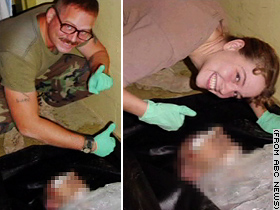
Why the cropping and blurring? This is usually done for one of two reasons. One, to avoid upsetting the readers. As I have suggested many times before, this is obscene (note: the primary meaning of obscene is 'Offensive to chastity or modesty; expressing or presenting to the mind or view something which delicacy, purity, and decency forbid to be exposed' where the alternate meaning is 'foul; fifthy; disgusting.'). Two, to protect the rights of the victim. This is an even more obscene excuse, since there was no interest in protecting the rights of the victim from being abused, tortured and killed.
(The Guardian) How Abu Ghraib torture victim faces final indignity: an unmarked grave. By Luke Harding. June 1, 2004.
In the erratically refrigerated vault of Baghdad's overcrowded mortuary lies an unclaimed corpse: number E63. For the past four and a half months, the most famous victim of the Abu Ghraib torture scandal, whose battered body was photographed wrapped in plastic sheeting, has been waiting for someone to collect him. So far nobody has.The precise circumstances of Manadel al-Jamadi's death in US custody are unknown. But leaked documents from an ongoing Pentagon investigation show Jamadi died during a CIA interrogation in the jail on November 4 last year, after being beaten up in the showers.
CIA officers insisted on questioning him with a hood over his head. It was only when he slumped over dead that they took off the hood and found he had severe facial injuries.
Afterwards two US guards at the prison west of Baghdad, Charles Graner and Sabrina Harman, posed for photos with his body, grinning and doing a "thumbs up".
The Pentagon is now investigating Jamadi's death together with at least 27 other suspicious deaths in US custody in Iraq and Afghanistan since 2001.
The Guardian has learned that US officials released Jamadi's body to the International Committee of the Red Cross only on February 11 - more than three months after his death. The Red Cross delivered his body to Baghdad's mortuary the same day.
The US death certificate issued for Jamadi contains no cause of death and no explanation for his severe cheek wound.
Last night human rights organisations in Iraq, as well as sources inside the coalition, said the case was not isolated - and that the US military had been involved in a systemic attempt to conceal the deaths of prisoners in custody. The military routinely declined to perform postmortem examinations on Iraqi prisoners, provided incomplete or misleading death certificates, and deliberately failed to inform the prisoners' families, they allege.
One senior source inside the Iraqi Assistance Centre, the organisation set up by the coalition to compensate Iraqis for loss or death, yesterday claimed that US military doctors routinely wrote "heart attack" on the death certificate of prisoners who had died from other causes, sometimes during interrogation.
"It's astonishing. They are all heart attack victims. They even write heart attack when the detainee died because he was shot. We have dozens of cases like this," the coalition source told the Guardian.
The source added: "Our lawyer is familiar with the phrase heart attack, and what it really means." Adil Mohammad Alami, a lawyer with the Human Rights Organisation of Iraq, said: "We have numerous cases where the US military kills someone, takes their ID, and then dumps their body at the morgue without any credentials."
According to medical sources at Baghdad's main forensic medico-legal institute, keeping Jamadi's body refrigerated for three months made it difficult to establish the real cause of his death. "You can only do an autopsy for the first 40 days. After that the body changes," one senior doctor said. "The cell tissue in the body deteriorates and the blood clots."
The fact that Jamadi's body is still lying in Baghdad's overcrowded mortuary suggests that his family may not know of his death. It was not clear last night what steps - if any - the US authorities had taken to inform them.
Asked whether they had tried to locate the family, coalition officials said last night they did not have "enough information" to give an answer.
Yesterday the head of Baghdad's forensic institute, Faik Amin Baker, said the coalition rarely provided details. "It isn't our responsibility to track down families. And we don't do autopsies unless we have a request from the police."
He added: "If Mr Jamadi's family haven't been told of his death, they probably don't know he's here. They may think he's still alive. It's very simple."
The US military has not revealed details of Jamadi's arrest. But in an email leaked by Sgt Ivan "Chip" Frederick, one of seven guards at Abu Ghraib now facing charges, it appears that Jamadi was under the control of"other government agencies" when he died - in other words, the CIA and its paramilitary employees.
"They stressed him out so bad that the man passed away. They put his body in a body bag and packed him in ice for approximately 24 hours in the shower. The next day the medics came and put his body on a stretcher, placed a fake IV [intravenous drip] in his arm and took him away," Sgt Frederick wrote.
According to the New Yorker magazine, Jamadi was never entered into the prison's inmate-control system, "and therefore never had a number".
In evidence given in a closed military hearing earlier this month, one prison guard, Specialist Jason Kenner, described what had happened after Jamadi's death. A battle had "raged" between the CIA and military interrogators over who should get rid of the body, he said.
Documents show that two CIA personnel and a contract translator were present when he died. It is not known who beat him in the face. But internal US medical reports show he died from "blunt force injuries complicated by compromised respiration".
Yesterday, as relatives crowded outside the mortuary, more bodies arrived in blood-splattered police vehicles.
"Under Saddam we got 16 corpses a month. Now we get 40 or 50 a day," Walid Abu Zahra, a mortuary worker, said. "Although we have a generator, we have a problem with power. The generator stops for half an hour each day. This means we can't keep bodies for more than 40 days."
Unless Jamadi's family arrive soon, staff say he will be buried in an unmarked grave in the vast "Valley of Peace" cemetery in Najaf.
"We keep photos of the dead," Mr Zahra said, "just in case. You never know whether the family will turn up."
(Washington Post) Videos Amplify Picture of Violence, by Josh White, Christian Davenport and Scott Higham. May 21, 2004.
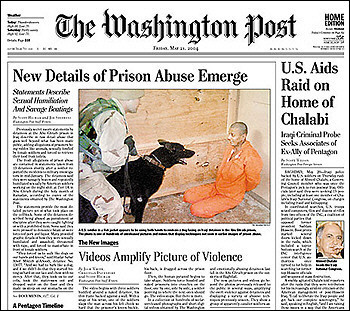
The video begins with three soldiers huddled around a naked detainee, his thin frame backed against a wall. With a snap of his wrist, one of the soldiers slaps the man across his left cheek so hard that the prisoner's knees buckle. Another detainee, handcuffed and on his back, is dragged across the prison floor.
Then, the human pyramid begins to take shape. Soldiers force hooded and naked prisoners into crouches on the floor, one by one, side by side, a soldier pointing to where the next ones should go. The grainy video stops. But there is more.
In a collection of hundreds of so-far-unreleased photographs and short digital videos obtained by The Washington Post, U.S. soldiers are shown physically and emotionally abusing detainees last fall in the Abu Ghraib prison on the outskirts of Baghdad.
The new pictures and videos go beyond the photos previously released to the public in several ways, amplifying the overt violence against detainees and displaying a variety of abusive techniques previously unseen. They show a group of apparently cavalier soldiers assaulting prisoners, forcing detainees to masturbate, and standing over a naked prisoner while holding a shotgun. Some of the videos echo scenes in previously released still photographs -- such as the stacking of naked detainees -- but the video images render the incidents more vividly.
Defense Department spokesman Lawrence T. DiRita said the photographs, by description, sounded like those the Pentagon has exhibited to members of Congress and that Defense Secretary Donald H. Rumsfeld had warned might yet become public. "There are a series of investigations going on as a result of the disclosure of the activities depicted on photos," DiRita said last night.
The new images do not shed light on who directed the abuse, a question central to the court cases of the 372nd Military Police Company soldiers charged in the abuse scandal. But the pictures do show soldiers appearing to delight in the abuses, and they starkly reveal several detainees cowering in fear.
In one video clip, five hooded and naked detainees stand against the wall in the darkness, each masturbating, with two other hooded detainees crouched at their feet. Another shows a prisoner handcuffed to the outside of a cell door. He repeatedly slams his head into the green metal, leaving streaks of blood before he ultimately collapses at the feet of a cameraman.
In one photo, a soldier is seen cocking his fist as he holds a hooded detainee in a headlock amid a pile of several detainees. Later, he is seen kneeling atop the same pile, flexing his muscles, a broad smile on his face, posing.
Another soldier is seen in a photo brandishing a black baton as a naked prisoner -- cuffed at the ankles and smeared with a brown substance -- stands at the center of the prison hallway and holds his arms spread to either side.
Detainees recoil from unmuzzled dogs in at least four photos.
In one, a prisoner in an orange jumpsuit sits up against a wall, his hands behind his back. His fear is unmistakable as a black dog snarls at him, the animal's long, sharp teeth bared inches from his face. The dog is leashed by an unidentified U.S. soldier in a flak jacket and wool hat, the soldier using both hands to keep the dog restrained.
In another photo, the same handler has the black dog, which this time looks ready to pounce as a naked detainee shrinks away in the middle of a prison hallway, his hands defensively up in front of him. Another soldier, his hands in his pockets, watches.
The photos continue, showing an array of abuse in what appear to be different rooms, cells, showers and hallways of Abu Ghraib.
Hooded and cloaked men are handcuffed to hallway rails. A prisoner in flexible handcuffs is made to use a banana to simulate anal sex. Two naked male detainees are handcuffed to each other. A naked detainee hangs upside down from a top bunk. Another naked detainee grimaces, his face pressed against the ground, a soldier bending his arm behind his back. Blood covers the detainee's left knee, and another soldier grabs his right leg.
In one photo, a detainee is stripped to his underwear, in a hood. He is standing, crouched, on top of two boxes of MRE military meals, his arms cuffed around his left knee, his right ankle chained to a cell door.
Another detainee appears to be the victim of a cruel joke: A photo shows the man's deformed left hand emerging from an orange jumpsuit, the words "The Claw" written in English on his left breast pocket. A crude drawing of the man's hand appears on the back of his jumpsuit in another photo, with "The Claw" scrawled across his shoulder blades in black ink.
The situation inside the prison became so chaotic that U.S. soldiers turned their cameras on themselves, filming scenes of consensual sex.
Photographs and videos from Abu Ghraib were presented to Army investigators in January. They began to surface publicly last month, severely damaging the U.S. reputation in the Arab world.
"Be on notice," Rumsfeld said in a standing-room-only Senate hearing room May 8. "There are a lot more photographs and videos that exist. If these are released to the public, obviously it's going to make matters worse."

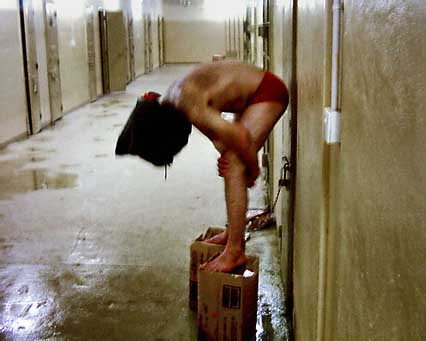
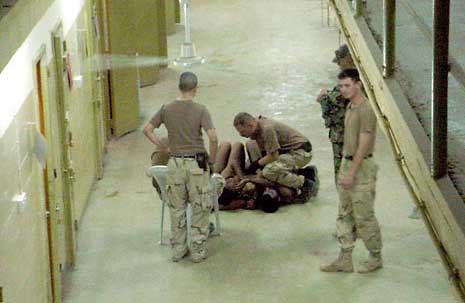
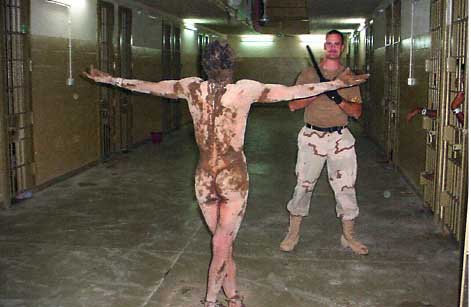
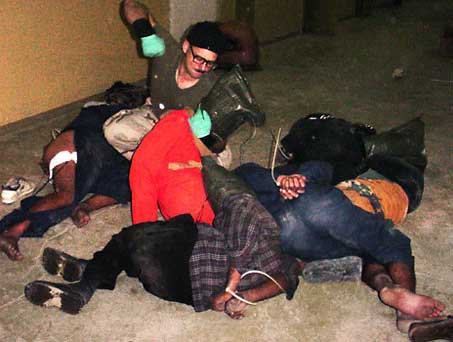
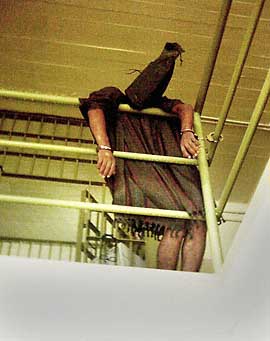
The edited video excerpt is from a collection of short digital video files obtained by The Washington Post. The videos appear to show U.S. soldiers abusing detainees last fall in Abu Ghraib prison.
In this video, soldiers are shown apparently attempting to arrange a human pyramid with naked Iraqi prisoners -- a scene similar to those also shown in previously obtained photographs.
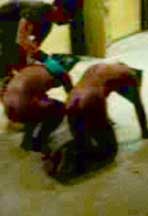
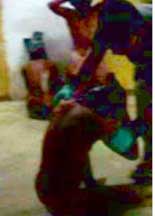
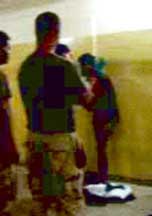
The Susan Sontag article in the New York Times was accompanied by three Abu Ghraib photos. It is interesting to note that these are similar to previously published photos, but they are not identical. In the following, the new photos are shown on the left and the corresponding old photos are shown on the right.
In the first photo, we now see a US soldier who can be identified by his face and bulging waistline. In the second photo, we now see that the Iraqi prisoner kneeling on the ground is not hooded. In the third photo, more of the body of the leashed Iraqi man can be seen. It is also said that there is another version of this photo in which Megan Ambuhl is visible in the background.
I am simply reporting these observations and I don't have any conspiracy theory to offer. I report, you decide.
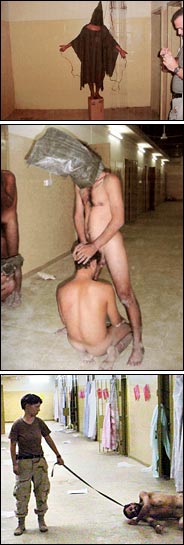 |
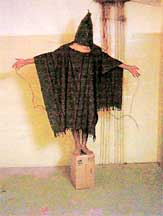
|
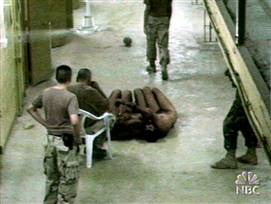
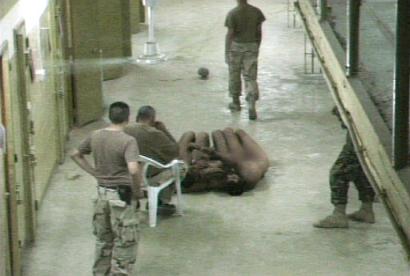
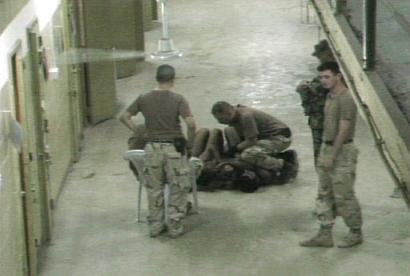
(MSBNC) New photos show Abu Ghraib tactics. May 26, 2004.
A series of photographs obtained exclusively by NBC News depicts what sources said was the aggressive interrogation of three naked Iraqi prisoners at Abu Ghraib, the detention facility outside Baghdad that is at the center of the scandal over U.S. mistreatment of Iraqi detainees
In one of the photos, a U.S. soldier can be seen pressing his knee into the neck of one of the three prisoners, who have been forced to huddle together on the floor.Sources told NBC News that some of the men in the photos were U.S. military intelligence officers who appeared to be directing the interrogation. One of the men identified as a military intelligence officer appears to have thrown an unidentified object at the prisoners.
It was not clear to what extent the new photographs, which were provided to NBC News on condition that their source not be revealed, showed standard procedures at Abu Ghraib.
NBC News’ Robert Windrem reported from New York that the prisoners were being interrogated in connection with the shooting of a military police sergeant by a detainee, not as part of an intelligence interview.
That could suggest that the interrogation session was not representative of normal tactics used at the prison, where hundreds of photographs and video clips have depicted U.S. guards abusing and sexually humiliating Iraqi prisoners.
(Washington Post) Dates on Prison Photos Show Two Phases of Abuse. By Scott Higham, Joe Stephens and Josh White. June 1, 2004.
On May 1, a U.S. Army investigator took the stand in a criminal proceeding in Baghdad against one of the seven military police soldiers charged in the Abu Ghraib prison scandal. There was, he said, "absolutely no evidence" that military intelligence officers or the military police chain of command had authorized the abuse to aid interrogations.
"These individuals were acting on their own," said Army special agent Tyler Pieron, who investigated the case for the Criminal Investigation Division. "The photos I saw, and the totality of our interviews, show that certain individuals were just having fun at the expense of the prisoners. Taking pictures of sexual positions, the assaults and things along that nature were done simply because they could. It all happened after hours. The fear instilled in the prisoners after these incidents may have been a benefit, but I don't know for sure."
A month later, that assessment has hardened into the accepted position on the abuse scandal for the Bush administration and the Pentagon. Yet an analysis of the dates of the photographs that form the heart of the case against the MPs provides a more nuanced picture.
Some of the photographs support the theory that MPs sought to humiliate prisoners for entertainment. The infamous shots show a naked human pyramid, a hooded man standing on a box and detainees forced to masturbate -- acts that apparently were staged to punish prisoners or amuse guards, not specifically to coerce confessions for military intelligence (MI).
But questions remain about the shots of snarling dogs intimidating detainees. The photos were taken weeks after the most publicized MP abuse occurred, according to date stamps accompanying photographs obtained by The Washington Post. The date stamps, which are in a database obtained by The Post that was apparently compiled by military investigators, show that the widely published photograph of a naked man confronted by unmuzzled German shepherds was taken on Dec. 12 -- a month after the human pyramid and during a period when military intelligence officers were in formal control of the prison.
The date stamps reveal that the recording of the abuses started shortly after the MPs arrived at the prison and built to a crescendo of perversity, with the naked human pyramid on Nov. 8. One of the photographed incidents stands out because it contains military intelligence officers in the frame -- showing soldiers gathered around three naked men lying shackled together on Oct. 25. Finally, the photographs suggest that two distinct types of abuse occurred at the prison. First, sexual humiliation and crude brutality at the hands of the MPs. Then, the more targeted use of dogs.
The photographs have always been a tantalizing but limited body of evidence. They are hard to dispute, but it is also hard to know what happened outside the frame or in between the photographs. Transcripts show that investigators aimed to get the stories behind the images.
"Our main purpose was to identify the personnel in the photos; we also wanted to find out if MI told MPs to do these acts," Pieron said. "If so, we wanted to know who told them; that's why we interviewed everyone. No one said, 'Do this to that person,' or anything specific."
Of the seven MPs charged in the case, at least three have given statements suggesting that military intelligence fostered the abuse. But those MPs provided few specifics and did not identify any military intelligence officers by name. The MPs said other soldiers -- Staff Sgt. Ivan L. "Chip" Frederick II and Spec. Charles A. Graner Jr. -- acted as liaisons with military intelligence, but one soldier said that "nothing was ever in writing." Graner and Frederick have invoked their right against self-incrimination and declined to give statements.
Maj. Gen. Antonio M. Taguba, whom top commanders asked to look into the abuse, said in his report that he suspected that two military intelligence commanders at the prison and two civilian contractors working with military intelligence were "either directly or indirectly responsible for the abuses."
Maj. Gen. George R. Fay is now investigating the role of military intelligence in the scandal.
Taguba's report lists 13 acts of "intentional abuse" that form the basis of the criminal charges against the MPs, who are all members of the 372nd Military Police Company based in Cresaptown, Md. The abuse first occurred shortly after the 372nd arrived at Abu Ghraib on Oct. 15, taking control of Tier 1A, which held prisoners wanted for questioning by military intelligence.
Around this time, the top commanders issued new rules for interrogations. A sheet labeled "Interrogation Rules of Engagement" was posted at the prison, requiring the top general's approval for harsher methods, including sleep deprivation, stress positions for detainees and intimidation with dogs. The rules noted that Geneva Conventions applied and commanded that "detainees will NEVER be touched in a malicious or unwanted manner."
But there is evidence that those rules were already being violated.
In mid-October -- the exact date is not specified -- Red Cross officials visited Tier 1A. They "witnessed the practice of keeping persons deprived of their liberty completely naked in totally empty concrete cells and in total darkness," a Red Cross report states. When Red Cross officials complained, "The military intelligence officer in charge of the interrogation explained that this practice was 'part of the process,' " the report states. The report also noted the detainees were being forced to wear women's underwear.
The 372nd MPs' digital cameras soon started recording the images of naked Iraqis.
In the photographs obtained by The Post, the earliest abuse appears in those dated Oct. 17 and Oct. 18. One shows a hooded Iraqi handcuffed to the bars of his cell; another shows a handcuffed naked man with women's underwear covering his head.
Spec. Sabrina D. Harman, one of the charged MPs, later told investigators she had heard that it was standard operating procedure to strip-search the detainees on Tier 1A, and that female guards were allowed to be present. But Harman said she was unsure who had told her that: "Either MI, SSG Frederick or CPL Graner."
The next photograph in the sequence is the famous shot of Pfc. Lynndie R. England holding a dog leash fastened around the neck of a naked man. It is dated Oct. 24.
Spec. Roman Krol, 23, a military intelligence interrogator and a reservist with the 325th Military Intelligence Battalion in Devens, Mass., said he witnessed the scene during a late-night visit he made to prisoners he had been interrogating on Tier 1A.
"I said, 'People are stupid,' and I just kept on walking," he said in his first public interview. "If I knew that our people were telling them to do that, I would try to stop it. I just didn't know. I don't want to get into it that deep. I basically didn't ask anyone anything."
The night after the incident, soldiers on the cellblock gathered around three shackled naked men splayed out on the floor. Krol identified himself in one photograph standing to the side while an MP is hunched over the three men, who were being disciplined for allegedly raping a boy in the prison.
Krol also said he was just wandering by when the incident occurred and thought it violated the tenets of good interrogation.
He said he "guessed someone told the MPs" to soften up Iraqi detainees. But he said he never raised concerns with the MPs, other military intelligence officers or anyone in his chain of command, choosing instead to keep what he saw to himself.
"I really don't know how it got started," said Krol, now back in the United States after a two-month assignment interrogating prisoners at Abu Ghraib. "It's [military police's] job, I guess. I didn't tell them what to do, and they didn't tell me what to do."
It was "immoral," he says now.
"I saw this going on. I just stood there for a few minutes. I don't know why they were doing it. They were brutal, but it's their job to handle the prisoners."
He added: "They were yelling at them. Whatever they were doing, they were doing it and I didn't care."
Krol also identified two others in the picture, a civilian translator, Adel L. Nakhla, and a military intelligence officer, Spec. Armin John Cruz. Krol said that he believed the man standing next to him in uniform was an MP whose name he does not know, and that Graner was kneeling over the three men. Other sources have identified a third military intelligence officer in the picture, Spec. Israel Rivera.
The photograph is significant because it places military intelligence at the scene of what is now considered a criminal act in the cases against the MPs. After that incident, Krol said, he stopped visiting the cellblock during the night shift. "I didn't want to see anything anymore," he said.
Krol said that was the only abuse he witnessed before leaving the prison in mid-November. He said the abuse was not designed to glean military intelligence. "I would never tell anyone to do this," he said. "If you do this, it's likely they will never talk to you."
Krol, Cruz, Rivera and Nakhla are all listed as witnesses in the cases against the MPs. Cruz and Rivera have declined to testify and invoked their right against self-incrimination, documents show. So has Nakhla, who works for the Titan Corp.
The next photograph in the sequence is the one of the hooded man standing on a military food box, his arms outstretched and wires attached to his extremities. It is dated Nov. 5, which conflicts with military documents that say it was taken on Nov. 8. Also on Nov. 5, Graner and Harman posed with a dead body left on the cellblock.
"We would spray air freshener to cover the scent," said Spec. Bruce Brown, an MP testifying at a preliminary court hearing. "MI or OGA interrogated this guy, and somehow he died. They finally took the body away." OGA stands for "other government agency," a common term for the CIA.
Spec. Jason A. Kenner, another MP, testified that officers from other government agencies and a Navy SEAL team brought the detainee in alive with a bag over his head; Kenner said he later saw that the man had been severely beaten on his face. OGA officers took the detainee to a shower room used for interrogations, Kenner said, and shackled him to a wall.
"About an hour later, he died on them," Kenner testified. "They decided to put him on ice. There was a battle between [OGA] and MI as to who was going to take care of the body. A couple days later, he was finally disposed of."
Five of the 13 acts of abuse -- the most by far -- occurred on one night, Nov. 8. That is when the MPs built a naked human pyramid with seven detainees accused of inciting a riot in another part of the prison. The MPs told investigators that Frederick and Graner orchestrated the incident. England, who did not work on the cellblock and came by that night to celebrate her birthday with her friends, told investigators that Frederick photographed the pyramid. Graner and Harman posed, smiling, behind the naked bodies.
Also on Nov. 8, prisoners were forced to masturbate, arranged in sexually explicit positions and punched by Frederick and Graner, according to some of the MPs' statements.
Sgt. Samuel Provance, a military intelligence systems analyst at the prison, testified that events of Nov. 8 clearly violated the interrogation rules of engagement.
"I have never heard of any of these techniques used by MI," he said at a hearing, adding that inexperience was to blame. "It was confusing the way the place was run. It was an important mission run by reservists who did not know what they were doing. They were just on their own."
The prosecution cases against the MPs so far have focused on the events of Nov. 8 and a few nights -- Oct. 24 and 25, and Nov. 5. Some of the MPs appear from documents and testimony to have had limited involvement.
Spec. Jeremy C. Sivits, an auto mechanic whose primary jobs at Abu Ghraib were to maintain a fleet of light vehicles and fill prison generators with fuel, apparently was in the cellblock only once, for a total of 30 minutes. On May 19, Sivits pleaded guilty to photographing some of the abuse and not trying to stop it.
Spec. Megan M. Ambuhl, who by at least two accounts was standing on an upper level looking down on the alleged abuse, appears not to have touched any of the detainees. She is pictured in only one photograph watching England hold the dog leash. There is also evidence that Sivits and Ambuhl helped a detainee who was punched in the chest by another MP.
At Ambuhl's Article 32 hearing, a preliminary step toward a court-martial, the investigating officer concluded that while she was present for the pyramid and the forced masturbation, there was insufficient evidence to show that she participated. He did find enough evidence to allow charges to proceed that she conspired with the others in the dog-leash incident and was derelict in her duty for not protecting detainees.
The last of the iconic images in the sequence is of the naked man being threatened by dogs and cowering to cover his genitals. The date stamp shows it was taken Dec. 12.
Col. Thomas M. Pappas, the military police commander at the prison, said in transcripts accompanying Taguba's report that the idea to use dogs came from Maj. Gen. Geoffrey D. Miller, who was in charge of the military detention facility at Guantanamo Bay, Cuba.
By then, Pappas had been given tactical command of Abu Ghraib, in an order dated Nov. 19, making military intelligence responsible for the MPs conducting detainee operations. The top U.S. commander in Iraq, Lt. Gen. Ricardo S. Sanchez, has testified that the order gave military intelligence responsibility only for protection of the facility. But it gave Pappas responsibility for "security of detainees and base protection," according to a copy of its classified language.
On Nov. 24, a riot occurred in an outdoor compound at the prison. Nine U.S. soldiers were injured, three detainees were killed by military police and nine other detainees were wounded. Also that day, on Tier 1A, an MP was shot by a detainee, who had obtained a weapon from an Iraqi prison guard. Five military dogs were brought into the cellblock "to either intimidate or cause fear or stress," Taguba noted during his interview with Pappas.
In his report, Taguba lists using unmuzzled military dogs to intimidate and frighten detainees as one of the 13 intentional acts of abuse.
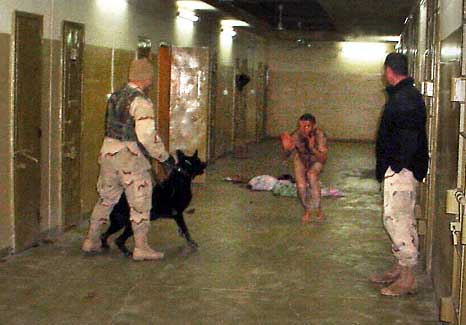
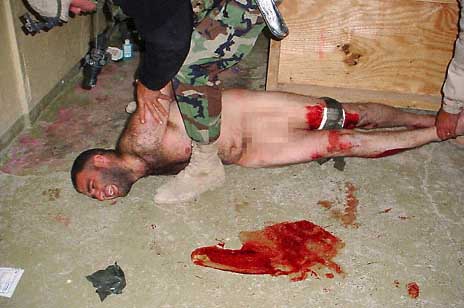
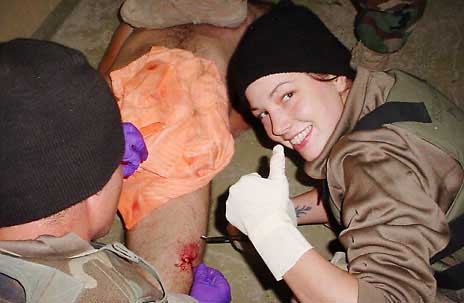
(Washington Post) Use of Dogs to Scare Prisoners Was Authorized. By Josh White and Scott Higham. June 11, 2004.
U.S. intelligence personnel ordered military dog handlers at the Abu Ghraib prison in Iraq to use unmuzzled dogs to frighten and intimidate detainees during interrogations late last year, a plan approved by the highest-ranking military intelligence officer at the facility, according to sworn statements the handlers provided to military investigators.
A military intelligence interrogator also told investigators that two dog handlers at Abu Ghraib were "having a contest" to see how many detainees they could make involuntarily urinate out of fear of the dogs, according to the previously undisclosed statements obtained by The Washington Post.
The statements by the dog handlers provide the clearest indication yet that military intelligence personnel were deeply involved in tactics later deemed by a U.S. Army general to be "sadistic, blatant and wanton criminal abuses."
President Bush and top Pentagon officials have said the criminal abuse at Abu Ghraib was confined to a small group of rogue military police soldiers who stripped detainees naked, beat them and photographed them in humiliating sexual poses. An Army investigation into the abuse condemned the MPs for those practices, but also included the use of unmuzzled dogs to frighten detainees among the "intentional abuse."
So far, the only charges to emerge have been against seven MPs and do not include any dog incidents, even though such use of dogs is an apparent violation of the Geneva Conventions and the Army's field manual. The military intelligence officer in charge of Abu Ghraib later told investigators that the use of unmuzzled dogs in interrogation sessions was recommended by a two-star general and that it was "okay."
The newly obtained documents reinforce the picture that the abuse falls into two categories: sexual humiliation and beatings at the hands of MPs, and intimidation using dogs that is clearly tied to military intelligence. The sexual abuse happened weeks and even months before the dog incidents, some of which appear to be part of an organized strategy by military intelligence to scare detainees into talking, according to the statements.
Sgts. Michael J. Smith and Santos A. Cardona, Army dog handlers assigned to Abu Ghraib, told investigators that military intelligence personnel requested that they bring their dogs to prison interrogation sites multiple times to assist in questioning detainees in December and January. Col. Thomas M. Pappas, who was in charge of military intelligence at the prison, told both soldiers that the use of dogs in interrogations had been approved, according to the statements.
"I have talked to Col. Papus [sic] and he said it was good to go," Smith told an investigator on Jan. 23.
Neither Smith nor Cardona has been charged in connection with the abuse at Abu Ghraib. "It's all under investigation," said Lt. Col. Pamela Hart, an Army spokeswoman.
The men could not be reached yesterday to comment. Two officers at the U.S. Army Trial Defense Service said that a military lawyer has been assigned to Cardona and that a message seeking a comment would be relayed to the attorney. The officers said they did not know whether a lawyer from the Army's defense service had been assigned to represent Smith.
In Army memos regarding interrogation techniques at the prison, the use of military working dogs was specifically allowed -- as long as higher-ranking officers approved the measures. According to one military intelligence memo obtained by The Post, the officer in charge of the military intelligence-run interrogation center at the prison had to approve the use of dogs in interrogations. There is no explanation in the memo of what parameters would have to be in place -- for example, whether the dogs would be muzzled or unmuzzled -- or what the dogs would be allowed to do. The Army previously has said that the commanding general of U.S. troops in Iraq -- Lt. Gen. Ricardo S. Sanchez -- would have had to approve the use of dogs.
Human rights experts said the use of dogs at Abu Ghraib violates longstanding tenets regulating the treatment of prisoners and civilians under the control of an occupying force, including the Army's field manual, which prohibits "acts of violence or intimidation" by American soldiers.
"Using dogs to frighten and intimidate prisoners is a violation of the Geneva Convention," said Elisa Massimino, Washington director of Human Rights First, an international organization based in New York. "It's a violation of U.S. policy as stated in the Army field manual, and it's a violation of the prohibition against cruel treatment."
The dog teams at Abu Ghraib were part of a security detail that also searched for weapons, explosives and contraband. The general in charge of military prisons in Iraq, including Abu Ghraib, said the dog teams were under the control of military intelligence but had no training or experience in helping with interrogations.
Cardona's dog, a tan Belgian Malinois named Duco, was trained to be part of a narcotics and patrol team. Cardona told investigators he also helped military intelligence with two interrogations and later was summoned by military police to draw information out of a detainee on Tier 1 of the prison, site of the worst documented abuse.
Smith said military intelligence personnel asked him to instill fear in detainees. He said that he would bring his dog, a black Belgian shepherd named Marco, to the tier specifically to scare prisoners after they were pulled out of their cells. At the behest of interrogators, he said, in some cases he would bring the barking dog to within six inches of the prisoners.
"Is using the dog in this manner an allowable tool by the MI interrogators?" an investigator asked Smith.
"Yes," he replied.
The dog handlers arrived at Abu Ghraib in late November, sometime after the abuse of detainees had been captured in photographs, including the images of the naked human pyramid and forced masturbation.
Master-at-Arms 1st Class William J. Kimbro, a Navy dog handler, said he was summoned to Tier 1 one night in November to help search a cell for explosives using his dog, Nicky, a black and tan Belgian Malinois. Earlier that night -- records indicate it was Nov. 24 -- a prisoner had allegedly been found with a weapon. When Kimbro and Nicky concluded the search, they were called to the second floor of the cellblock to search another cell.
"There was a bunch of yelling going on in the cell and my dog started going ape," Kimbro told investigators, adding that interrogators were yelling at a detainee in the corner. "I remember one of the males saying to the detainee, if the detainee did not provide the information the guy was asking about, then he would have me let . . . my dog go on him."
Kimbro said he was surprised by the comment and tried to calm Nicky down. He soon left, he said, upset that interrogators had tried to use his dog as an interrogation tool.
"I was leaving because this is not what my dog is trained for," Kimbro said in one of three statements he provided to investigators. "We do not use our dogs for interrogation purposes."
Kimbro was singled out for praise in Maj. Gen. Antonio M. Taguba's report about abuse at the prison for refusing "to participate in improper interrogations despite significant pressure from the MI personnel at Abu Ghraib."
Smith and Cardona said they complied with the MI requests because they believed the tactics had been approved by Pappas, the military intelligence officer in charge of the prison. They told investigators that they spent time on the cellblocks, allowing their dogs to bark at the detainees.
They said a non-commissioned officer from military intelligence approached them in mid-December.
"He asked us if we could use our dogs for interrogation purposes," Cardona said in a statement. "They were trying to get it cleared. We went outside and saw Col. Pappas. He told us MI wanted to use the dogs for interrogations and he told us that they had received permission to use dogs in an interview."
Smith recalled the same conversation, saying he spoke with Pappas in the parking lot the night after Saddam Hussein was captured -- Dec. 14. He said he was told that the use of the dogs was permitted.
Later that night, the two dog handlers took their dogs to an interrogation booth holding a detainee. Interrogators told them the dogs did not need to be muzzled, they said.
"When we got to the room the detainee was sitting in the doorway, with his feet in the doorway and the door was open," Smith said. "My dog and Sgt. Cardona's dog were both barking at the detainee and we never got closer than 18 inches. Neither dog had a muzzle on."
Also in mid-December, the dog handlers said they were asked by one of the MPs, Staff Sgt. Ivan L. "Chip" Frederick II, for help in dealing with an uncooperative detainee. Part of what followed was captured in photographs that have come to define the abuse at Abu Ghraib: A naked prisoner was up against a wall, two dogs squaring off against him.
The detainee, identified in the documents as Ballendia Sadawi Mohammed, said he was suddenly snatched from his bed in cell No. 5 one night and sent into the hallway handcuffed.
"They sent the dogs toward me. I was scared," Mohammed told investigators. "The first dog bit my leg and injured me there and this was bad luck. The bite from the first dog caused me to have 12 stitches from the doctor of my left leg as a result I lost a lot of blood."
Spec. Sabrina D. Harman, a member of the 372nd Military Police Company, said she saw the incident and said the detainee was bitten after he tried to run from the dog and was cornered. Cardona, whose dog apparently bit the detainee twice, once on each leg, justified letting his dog go to the end of its leash because he believed the detainee was fighting with Spec. Charles A. Graner Jr.
Military investigative records show that Frederick and Graner were key participants in the abuse. Harman, who said she saw two other inmates with dog bites around late December, also has been charged.
In early January, Cardona said, he used his dog during an interrogation at the "Wood" facility at Abu Ghraib, a collection of wooden interrogation booths set up behind the prison. Cardona said a non-commissioned military intelligence officer asked him to bring his dog into a booth and make it bark to scare the prisoner.
"I asked him if he wanted Duco to be in a muzzle and he said no," Cardona told investigators. "We went into the booth and there was a detainee in the booth with a bag over his head. Duco barked at him for about two or three minutes and they were asking the detainee questions."
On Jan. 13, Spec. John Harold Ketzer, a military intelligence interrogator, saw a dog team corner two male prisoners against a wall, one prisoner hiding behind the other and screaming, he later told investigators.
"When I asked what was going on in the cell, the handler stated that he was just scaring them, and that he and another of the handlers was having a contest to see how many detainees they could get to urinate on themselves," Ketzer said.
(Sydney Morning Herald) February 15, 2006.
(SBS) New Abu Ghraib Photos Revealed. February 15, 2006.
Graphic new photographs have emerged of prisoners being abused by US soldiers inside Iraq's Abu Ghraib prison, which apparently reveal a greater extent of mistreatment in the 2003 prisoner abuse scandal. The images, which have been shown on SBS’s Dateline program Wednesday, were taken at the same time as the infamous photographs of US soldiers abusing Iraqi prisoners inside Abu Ghraib, which sparked international outrage after they were leaked in 2004.
While some of the photographs are similar to the images made public two years ago, the latest photographs reveal further abuse including new incidents of killing, torture and sexual humiliation, the program’s producers said.
Dateline said the photos are the subject of a legal battle in the United States. The American Civil Liberties Union (ACLU) has been granted access to the photographs under Freedom of Information provisions, but the US government is currently appealing the decision. Executive producer Mike Carey said Dateline obtained a file of hundreds of pictures, some that have been seen before and others that show new abuses. Some photos feature prisoners in sexually humiliating acts that are deemed too graphic to be shown on the program, he said.
Video footage apparently shows one prisoner abusing himself by bashing his own head against a wall, while other photographs appear to show corpses. Mr Carey says he assumes other journalists might also have seen the photographs but does not know why they had not been released until now.
(BBC News) February 15, 2006.
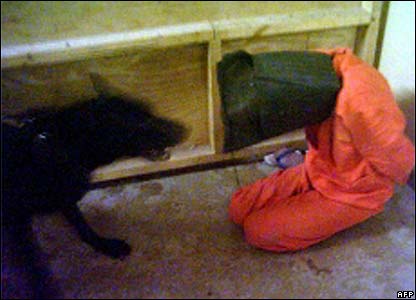
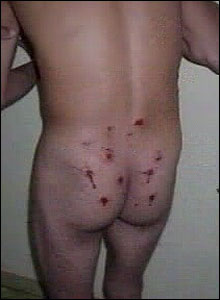
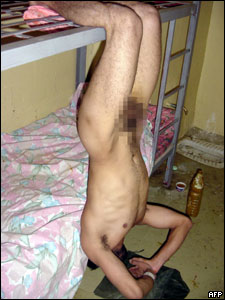

(The Guardian) February 15, 2006.
Previously unpublished images showing US troops apparently abusing detainees at Iraq's Abu Ghraib prison in 2003 were broadcast today by an Australian television station. Still and video images were broadcast on Dateline, a current affairs programme on SBS television, which appeared to show dead bodies and Iraqi prisoners being tortured by US troops.
In one piece of footage, an Iraqi detainee was seen slamming his head repeatedly into a metal door, with guards apparently unwilling to intervene and stop him. A still image showed a naked detainee with 11 non-fatal gunshot wounds to his buttocks.
SBS said it had obtained a file of hundreds of images and that many of them depicted dead bodies, bloody injuries and acts of sexual humiliation that were too graphic to be aired. In some of the film shown, naked male prisoners wearing hoods were seen being forced to masturbate in front of the camera.
The original photographs of abuse at Abu Ghraib caused worldwide outrage when they were leaked to US current affairs programme 60 Minutes in 2004. SBS said the new images were taken in late 2003 at around the same time as the previously publicised photographs, which included a series showing naked detainees arranged in "pyramids".
A number of the new images showed US soldiers who have already been convicted in military trials over the abuse scandal at the prison, including Private Lynndie England and Charles Graner.
It had been known that more images of the abuse at Abu Ghraib existed. At a Senate committee inquiry in May 2004, the US secretary of defence, Donald Rumsfeld, said that not all known photographs of the abuses at Abu Ghraib had been publicly released. Mr Rumsfeld told the inquiry: "Beyond abuse of prisoners, there are other photos that depict incidents of physical violence toward prisoners, acts that can only be described as blatantly sadistic, cruel and inhuman."
Dateline's production team interviewed US Congress members who had been given a private viewing of all the images depicting abuse from Abu Ghraib, including those that had not been published in the media. SBS refused to give details of the source of the photographs, but insisted it was confident of their credibility. It was impossible to independently confirm the images' authenticity. Producers said the new images were among photographs the American Civil Liberties Union was trying to obtain from the US government under a freedom of information request.
In September last year, a US district court upheld the request in a ruling covering scores of photographs and several videotapes. Government lawyers responded by saying an appeal was being considered, and the images were not immediately released.
Speaking on Dateline's programme today, Amrit Singh, a lawyer for the the civil liberties union said she hoped the broadcast of the new images would provide pressure for high-ranking officials to be held accountable for "systematic and widespread abuse".
In total, seven low-ranking US personnel have been disciplined over the images. Graner, a reservist, received the highest sentence and was jailed for 10 years.
There were reports Washington was trying to prevent the new images being broadcast in the US. The photographs were quickly picked up by Arabic television stations. It was feared they could add to tensions stirred up by the Danish cartoon row and Sunday's emergence of video showing British troops in Iraq apparently beating civilians in 2004.
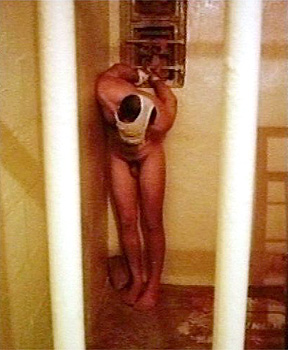
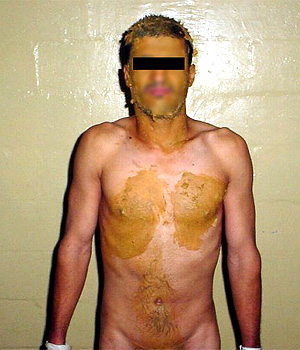
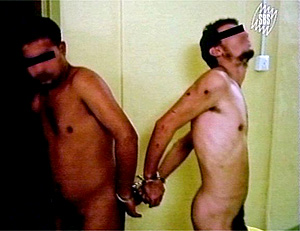
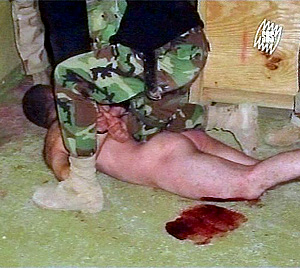
(Associated Press) U.S. Source: Nothing New in Abuse Photos. By Meraiah Foley. February 15, 2006.
An Australian television network aired previously unpublished video and photographs Wednesday of what it said was the abuse of Iraqis in U.S. military custody at Abu Ghraib prison in 2003, including a man beating his head against a cell door.
The images of naked prisoners, some bloodied and lying on the floor, were taken about the same time as earlier photos that sparked protests and outrage in the Middle East in 2004, the Special Broadcasting Service's ``Dateline'' program reported.
SBS refused to give details on the source of the photos and video clips but said they were among those the American Civil Liberties Union was trying to obtain from the U.S. government under a Freedom of Information request. Several new images, which could not be independently confirmed, appeared to show former Cpl. Charles Graner, Jr., who is serving a 10-year prison term at Fort Leavenworth, Kansas, after being convicted of abusing Iraqi captives. Many of the images, including some that appear to be corpses, were more graphic than those published in 2004, which prompted a U.S. congressional investigation and military trials for some soldiers involved.
In Washington, Pentagon spokesman Bryan Whitman said he did not know whether U.S. officials had reviewed the photos and video clips or whether they were among images the Pentagon has been withholding from public release since 2004. But another defense official said later Army officials had reviewed the photographs posted on the Sydney Morning Herald's Web site and matched them to images that were among those turned over to military authorities in Iraq in 2004 by a U.S. soldier. The official, who spoke on condition of anonymity because he was not authorized to address the matter publicly, said the photos contained no new information about abuse.
Whitman stressed it is U.S. policy to treat all detainees humanely. ``The abuses at Abu Ghraib have been fully investigated,'' Whitman said. ``When there have been abuses, this department has acted upon them promptly, investigated them thoroughly and where appropriate prosecuted individuals.''
More than 25 people have been held accountable for criminal acts and ``other failures'' at Abu Ghraib and it remains the view of the Pentagon that the release of additional images of abuse at the prison would be trigger new violence and threaten U.S. troops overseas, Whitman said. ``The department believes that a further release of images could only further inflame and possibly incite unnecessary violence in the world and would endanger our military men and women that are serving around the world,'' Whitman said. Based on Whitman's comments, it appeared the Pentagon did not intend to open a new investigation as a result of the latest publication of photos.
Defense Secretary Donald H. Rumsfeld, who was scheduled to hold a routine Pentagon news conference Wednesday afternoon, canceled his appearance for what his aides called scheduling reasons.
Iraqi officials condemned the images, which aired just days after the release of video allegedly showing British soldiers beating and kicking Iraqi males in the southern city of Amarah in 2003.
Labeed Abbawi, an adviser to Iraq's foreign minister, criticized such abuses but questioned the benefit of airing footage of events for which American soldiers had already been punished. ``I feel bringing up these issues is only going to add to heat to an already fragile situation in Iraq and they don't help anybody at all,'' Abbawi said.One of the video clips shown by SBS showed a group of naked men with bags over their heads standing together and masturbating. The network said they were forced to participate. Another video showed a handcuffed man repeatedly pounding his head against a metal cell door. The same prisoner was shown in other pictures, including one in which he is smeared in his own feces and another in which he dangles naked from the top bunk of a bed. SBS said the man was mentally ill and became a ``plaything'' for the guards who ``experimented with ways to restrain him.'' One photograph showed a man with a deep cut on his neck. The same man appears in another photo surrounded by men dressed in khaki shirts and pants, with one of the men pointing at the wound.
The SBS report said the man was identified in a U.S. Army report as detainee No. 10. He was thought to be an Iraqi general who had been resisting transfer from an outside prison camp into Abu Ghraib's inner cell blocks when soldiers pushed him against a wall, then noticed blood coming from under his hood, the network said.
A 1 1/2-inch (3.8-centimeter) cut on the man's neck was then sutured by an army medic, SBS said, quoting an unspecified army report. Another photo showed a man lying dead in the dirt with blood coming out of his head. The SBS also showed photographs of a bloodied cell block and a dead body, saying the man had been killed during a CIA interrogation.
Another showed a dead prisoner identified only by the number 153399 who was killed during a riot at the prison. SBS said it spoke to two soldiers at Abu Ghraib who told the network that guards trying to contain the rioting ran out of rubber bullets and ``were ordered to use lethal rounds.'' ``The detainees were fenced in a camp compound, with nowhere to run or hide,'' the report said.
Uniformed men holding dogs on leashes as they threaten a hooded prisoner in an orange jumpsuit appear in at least one image as does a hooded and robed prisoner standing on a box with wires strapped to his finger. Another shows a man in green camouflage kneeling over a naked prisoner lying face down on the floor with a pool of blood by his left knee.
The SBS report also showed a photograph of a man with about 10 bright red wounds across his buttocks. Quoting an unspecified military report, the network said the man had been hit by ``MP personnel with a shotgun, using less than lethal rounds.'' Two women who the network said were prostitutes detained at the prison for 48 hours also appear in photographs dressed in regular clothes, with one of them baring her breasts.
The Arab satellite station Al-Jazeera aired brief excerpts of the Australian footage, which was broadcast as outrage spreads in the Muslim world over caricatures of the Prophet Muhammad deemed offensive to Islam and published in newspapers in Denmark and elsewhere.
The SBS broadcast said many of the new photos showed Graner having sex with Lynndie England, a 22-year-old reservist, but those were not shown. England is serving a three-year prison term for abusing detainees and has said Graner fathered her son. A U.S. district court in September upheld the request in a ruling covering scores of photographs and several videotapes. Government lawyers said it was considering an appeal, and the images were not immediately released.
In a statement e-mailed to The Associated Press, SBS said the ACLU had not seen the images sought under the Freedom of Information request, so it had not been able to confirm whether they were the same as those broadcast Wednesday. But the general description of the photographs the ACLU is seeking ``is consistent with the photographs we are releasing,'' the SBS statement said. ``'Dateline' is confident in the credibility of the source of these new photographs and videos,'' the SBS statement said. ``They are entirely consistent with descriptions of the unreleased photographs and videos from various U.S. army reports into the abuses.''At a Senate Armed Services Committee inquiry in May 2004, Rumsfeld testified that not all known photographs of the abuses at Abu Ghraib had been released publicly. ``Beyond abuse of prisoners, there are other photos that depict incidents of physical violence toward prisoners, acts that can only be described as blatantly sadistic, cruel and inhuman,'' Rumsfeld said at the time.
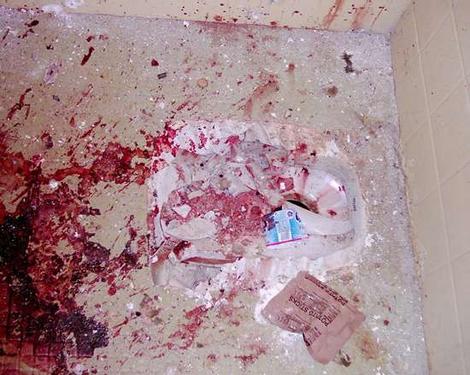
(Washington Post) Painted in Blood, an Abstract Expression of Horror. By Philip Kennicott. February 16, 2006.
From the beginning of the Abu Ghraib scandal, when the first images of torture and humiliation from the Iraqi prison appeared, we knew there were more. And now, two years later, they've begun to emerge. An Australian television network has put yet more scenes of blood and savagery into circulation, circumventing both the U.S. government's efforts to keep Abu Ghraib images out of the public eye and the gatekeeping of news organizations (including this newspaper), which have not published a substantial number of photographs they are holding.
Just as certainly as they will inflame the Arab and Muslim world, they will raise the question of whether it is responsible for Western news organizations to distribute them. And for bloggers to post them. And for pundits to debate them. Do they add anything new, or only open old wounds? Do they undo the work of investigation, trial and punishment that put men like Charles Graner, one of the original perpetrators, behind bars? Or do they underscore the inadequacy of that process, both the limited scope of who has been punished, and the apparently limited deterrent effect of the scandal? Reports of abuse continue to come in, from prisons in Afghanistan and Guantanamo Bay, and U.S. leaders, who denounce torture, have been accused of keeping the door open for abuses that are torture in all but name.
Newspapers that have held these images have been constrained, in large part, by the sheer graphic nature of them, especially the nudity. Other images are difficult to interpret and show things that are hard to identify. In the latter category is a photograph that began popping up on Web sites yesterday, of what seems to be a toilet floor covered with blood and litter, framed by a small glimpse of tiled walls. It suggests a bathroom turned into a holding cell, or perhaps a scene from a hospital or triage center, or a torture chamber. The blood on the floor instantly suggests the splatter and drip paintings of the abstract expressionists.
Newspapers have often turned to blood as a substitute for violence, showing photographs of the gore that lingers on streets long after the bodies -- too graphic to show -- have been cleared away. Here, in a photo that contains no particular information, no names, no certainty even about whether it shows what it seems to show, is the blood image in a new form. This is no substitute, no polite euphemism for what can't be shown. Blood as a substitute for death deflects horror; this blood demands answers.
Comparing blood to paint, violence to art, is dangerous, even repellent. But in one sense, the blood on this floor is exactly like the paint drippings of Jackson Pollock, who captured the visible traces of action, the visual memory of gestures. In Pollock's painting, the gestures fixed on canvas were often graceful, melodic even, with paint obeying the law of gravity with a gentle quiescence. If this is blood, we can only imagine what the gestures were.
What's powerful, and infinitely sad, about this bloody floor is the silence. Whatever happened in this room, it almost certainly was accompanied by a cacophony of pain. That's gone now. As is anyone involved with what happened there. The garbage on the floor, the opening of a toilet, suggest human beings reduced to refuse. The anonymity of those who may have suffered is absolute. Other photographs have appeared with faces decorously blacked out, a nod by those publishing the images to the dignity of the victims. Here, everything has been blotted out, and strangely enough, the dignity is now complete.
The victim is now just blood, there is no face to put on him or her, nothing we can say about what or where the wounds were, and how they happened. And in this abstraction from anything identifiable, the victim becomes completely, finally Human, not a particular man or woman, with a certain color of skin, or cut of hair, or any clothing to place him or her in the categories that we use to make sense of the faraway, the foreign or the frightening. The abstraction of blood leaves an open space for anyone looking at this picture to imagine himself or herself in its midst, to imagine, say, that the blood pooling on the floor like wax before it drains to the opening of a rank toilet is our own. And that these dull industrial tiles, with their insidious repetition of a pattern, are the last things we remembered before the lights went out.
Those who deplore the release of these images are right in that they may add no specific new evidence to a forensic or political or journalistic argument. And they draw us -- no, wrench us -- further from what Americans like to think of as "closure," the end of the shame, the end of the argument. But this one image, just a pattern of darkness on a canvas of cement and tile, opens up everything, because who can look at it without going there? If the original Abu Ghraib photographs compelled us to realize our connection to the perpetrators -- our soldiers, fighting our war -- this sad, silent image begs us to at least imagine that we are connected, in a deeper, human way, to the victims.
(Salon) The Abu Ghraib files. By Mark Benjamin. February 16, 2006.
Salon has obtained files and other electronic documents from an internal Army investigation into the Abu Ghraib prisoner-abuse scandal. The material, which includes more than 1,000 photographs, videos and supporting documents from the Army's probe, may represent all of the photographic and video evidence that pertains to that investigation.
The files, from the Army's Criminal Investigation Command (CID), include hundreds of images that have never been publicly released. Along with the unpublished material, the material obtained by Salon also appears to include all of the famous photographs published after the Abu Ghraib scandal broke in April 2004, as well as the photographs and videos published Wednesday by the Australian television news show "Dateline."
The source who gave the CID material to Salon is someone who spent time at Abu Ghraib as a uniformed member of the military and is familiar with the CID investigation.
The DVD containing the material includes a June 6, 2004, CID investigation report written by Special Agent James E. Seigmund. That report includes the following summary of the material included: "A review of all the computer media submitted to this office revealed a total of 1,325 images of suspected detainee abuse, 93 video files of suspected detainee abuse, 660 images of adult pornography, 546 images of suspected dead Iraqi detainees, 29 images of soldiers in simulated sexual acts, 20 images of a soldier with a Swastika drawn between his eyes, 37 images of Military Working dogs being used in abuse of detainees and 125 images of questionable acts."
A soldier identified as Sgt. Evans writes on a wall
next to an "unknown" hooded naked detainee.
Detainee handcuffed to bed frame with women's underwear on his face.
Spc. Charles Graner posing over a pile of detainees.
A "mentally deranged detainee who required special restraints due to his behavior"
Spc. Christopherson and an unknown detainee.
Manadel al-Jamadi, dead and packed in ice.
Staff Sgt. Ivan "Chip" Frederick clips his fingernails
as a detainee nicknamed "Gilligan" stands hooded on a box.
Testimony of Spc. Sabrina Harman: "I put wires on his hand.
I do not recall how. I was joking with him and told him if he fell off,
he would get electrocuted."
(Salon) Why we're publishing the new Abu Ghraib photos. Walter Shapiro. February 16, 2006.
The horrors carried out during the last three months of 2003 by U.S. soldiers at Abu Ghraib prison are shockingly familiar and, at the same time, oddly remote. The torture photographs that were published when the prisoner-abuse scandal first exploded have lost their power to shock. We have all seen the pictures repeatedly: a pyramid of unclothed prisoners; a naked detainee cowering in front of snarling dogs; captives wearing punitive hoods that seem borrowed from a medieval inquisition; American soldiers grinning over Iraqi dead bodies and, always, that chillingly ironic thumbs-up sign.
Eventually this visual repetition numbs the senses. All these ghastly images have been viewed so often that they seem to belong to a different war conducted by a different superpower in a different century. Yet the photographs that news organizations have so far published represent only a partial sample of the government's chilling documentary record from Abu Ghraib.
When Salon's national correspondent Mark Benjamin obtained the never-before-released photographs that accompany this essay, we had to both establish their authenticity and to answer the basic question of our justification for publishing. The images themselves partly answered the why-publish question for us. Speaking for myself, I remain haunted by one of the more seemingly banal pictures in this new collection from the dark side. Taken on Dec. 6, 2003, the photograph shows a uniformed and seemingly untroubled Army sergeant leaning against a corridor wall completing his paperwork. All routine, except standing next to the sergeant is a hooded and naked Iraqi prisoner. Just another day of methodical record-keeping at Abu Ghraib.
The other compelling reason for publishing these pictures is that the system itself broke down over Abu Ghraib. Beyond the collapse of military discipline and adherence to the basic rules of civilized behavior, Abu Ghraib also symbolized the failure of a democratic society to investigate well-documented abuses by its soldiers. After an initial flurry of outrage, the Republican-controlled Congress lost interest in investigating whether senior military officers -- and even Pentagon officials -- created a climate in which torture (yes, torture) flourished. In similar fashion, the Army still seems intent on ending this shameful story by jailing the likes of Lynndie England and Charles Graner. At least after the My Lai massacre during the Vietnam War, Lt. Calley was convicted.
Abu Ghraib cannot be allowed to fade away like some half-forgotten domestic political controversy, which may have prompted newsmagazine covers at the time, but now seems as irrelevant as the 2002 elections. Abu Ghraib is not an issue of partisan sound bites or refighting the decision to invade Iraq. Grotesque violations of every value that America proclaims occurred within the walls of that prison. These abuses were carried out by soldiers who wore our flag on their uniforms and apparently believed that Americans here at home would approve of their conduct. Rather than hiding what they did out of shame, they commemorated their sadism with a visual record.
That is why Salon is willing to publish these troubling photographs, even as we are ashamed to live in a country that somehow came to accept that torture and prisoner abuse were simply business as usual -- something that occurs while a sergeant catches up on his paperwork.
(Salon) Abu Ghraib and Salon. Joan Walsh. February 18, 2006.
In the wake of our publication Wednesday evening of photos from Abu Ghraib prison that had not previously been available to the public, Salon's readers have raised several issues that we'd like to address. The most important of these are: Why did we publish this material when we did? Was Salon somehow "sitting on" this material? And why didn't we publish everything we have?
We received a voluminous archive of Abu Ghraib materials a week before we published our story. With help from our news team, investigative reporter Mark Benjamin began the careful process of vetting what his source provided and determining what we had that was new and not simply duplicates or near-duplicates of images already available to the public.
This process took several days. As we were digging into the archive, the Australian television news show "Dateline" published its own Abu Ghraib file, with many, but not all, of the photos we were busy cataloging.
It's tough to be scooped, but it's tougher to live with the result of making bad judgment calls under the gun of a deadline. We accepted the risks posed by our choice not to rush to publish what we had without vetting and authenticating it, even after the Australian photos ran. We also realized we had two assets the excellent Australian report did not: some unique and disturbing photos of abuse, but maybe more important, documentation of what many of the photos depicted in the Army's own Criminal Investigation Command (CID) report -- information that allowed us to provide informative captions with our photos.
So we set out to create a photo portfolio that provided context for all the images shown. Our goal was to publish newsworthy images that hadn't been widely seen before, providing the best information that the CID investigation materials could offer.
In the end we published 18 photos. We ruled out photos that depicted horrific scenes that we couldn't be sure were the result of abuse -- while disturbing, certain subsets of images might be photos of people who arrived at the prison dead or injured, who were injured in the course of a battle and not during interrogation or torture.We felt that the 18 photos we chose represented a cross section of the types of psychological and physical abuse known to have occurred at Abu Ghraib -- in particular, sexual humiliation. The photos depicted almost routine nudity, along with many instances of male prisoners with their faces covered by women's underwear, as well as arguably the most disturbing image of the group, the scene of an allegedly mentally deranged prisoner apparently sodomizing himself with an unidentified object.
For now, there are two criticisms we'd like to answer. One is the suggestion from some readers that we should put the entire archive on our Web site. Another is the provocative, though I think disingenuous, demand that if we're willing to inflame Muslim sentiment with this awful photo gallery, then we should have also hosted -- and should now immediately publish -- the Danish cartoons of Mohammed that spread riots and violence throughout Europe and the Muslim world.
Let's take the last argument first, since I was bludgeoned with it by Tucker Carlson on MSNBC's "The Situation" Thursday night -- and, more important, since some of our readers are asking the question sincerely. I'm enormously proud of our coverage of the Danish cartoon controversy. We were among the first U.S. news organizations to give it significant attention, and from our very first story, we linked to Web sites hosting the cartoons in question, as we typically do with samples of media that have come under fire.
We're not a newspaper; we're a creature of the Web, and the cartoons are easily accessible in our world. We linked early and often, we got criticism for even linking, and meanwhile we covered the story from every imaginable angle: an interview with passionate Dutch legislator and Muslim reformer Hirsi Ali, who defended the cartoons and insisted they be shown everywhere; a nuanced examination of the politics behind the Jyllands-Posten decision to run the cartoons, by a liberal Danish intellectual; a tough analysis by Juan Cole; reporting from the streets of Morocco.Simply put, the cartoons are not being suppressed on the Web -- in fact, they're easy to find. Were they to disappear tomorrow thanks to some campaign or censorship, we'd have to seriously consider making them available on Salon, given their news value. For now, that's not the issue.
There's something essentially wrong about equating the Mohammed cartoons and the Abu Ghraib photos, anyway. The former are Op-Ed pieces commissioned by editors; the latter are images of actual events. We can and do condemn the hate and violence the cartoons provoked. But as Americans we are directly complicit in the violence that took place at a prison run by the American military. It is our story in a way that Danish cartoons can never be.
As Walter Shapiro argued so movingly in his piece explaining why we ran the photos, the point is not merely that Americans tortured these prisoners in our custody; the point is that our military personnel went to such great lengths to capture the humiliation on camera. It's a double violation, a double humiliation (and it's why we took care to obscure the identities of any victims whose faces were visible).
Abu Ghraib matters severely. It will go down in history as a terrible humiliation for our democracy, for our ideas about the rights of individuals and the responsibilities of conquering armies. For a brief scarring moment in 2004, just a few weeks really, we had a national crisis over Abu Ghraib. But after a short period of time, the pathologically secretive Bush administration announced the controversy was over, everyone was free to go back to what they were doing, there was nothing to look at here, move along.
A handful of low-level military personnel were indeed prosecuted; but the leaders of the prison and of the interrogation project never faced charges. And meanwhile, we learned from our leaders: Oh, by the way, there were many more photos, cataloged by the Pentagon and shared with some congressional leaders. But they weren't fit to be seen by the American public. So the government hid them away, and continues to do so -- despite losing in federal district court to a suit by the American Civil Liberties Union and the Center for Constitutional Rights seeking release of the images.
But what about the argument that publishing more evidence of Abu Ghraib abuse simply incites further violence against American targets? As an American news organization, we do not believe we should make decisions about censoring discussion and debate of our government, and our military, based on fear of extreme Muslim reaction. As Federal District Court Judge Alvin Hellerstein wrote in a decision in favor of the ACLU and CCR suit, rejecting administration arguments that the images would inflame terrorists: "Terrorists do not need pretexts for their barbarism."
Now Salon, we believe, has the archive the ACLU and CCR have sought. We face a series of decisions about what, if anything, further to do with it. We definitely intend to publish a significant amount of additional material in the near future. But we have also rejected the notion of a quick and dirty dump of the contents to the Web. Some significant portion of the documents we possess does not appear to relate at all to prisoner abuse at Abu Ghraib, and we can see no public interest served by publishing it.
So sticking with the bar we established for ourselves earlier this week, we will, at minimum, continue to work with the photos -- brand new and already published -- for which we can find documentation in the CID report, those we know the Army already found were evidence of abuse and/or torture. There are several disturbing videos we will attempt to hold to the same standard. Our staff will continue its reporting efforts to determine the legal, political and journalistic implications of those images. We will work to provide accurate and useful captions for whatever we publish.We know we'll publish more, but we don't know how much we'll publish, and we don't know exactly when. We may disappoint those who think we should post everything to the Web and let readers sort out their meaning. But to us, that seems an abdication of responsibility. If you come to the Abu Ghraib archive at Salon -- we have one, and it will grow -- you will have a sense of confidence that you understand the images and the stories behind them.
To people who say this should have been over in the spring of 2004, when CBS and the New Yorker first published disturbing images of torture, let me say, I agree. At that point, our government could have said, "Yes, we have many more of these disturbing photos, and here they are. Let's stare at them and feel grief and outrage and decide as a nation that this was a terrible breach of everything we stand for. Let's figure out the chain of command that led to this abuse. Let's go beyond punishing the low-level service members who participated. Let's uncover the institutional decisions that led to this depravity. Let's examine whether higher-ups imposed policies for aggressive interrogation that countenanced such appalling behavior."
Had the Pentagon and the White House done all that, maybe this would have been behind us almost two years ago. But of course, they didn't. This is an administration known for obsessive, scandalous secrecy; Abu Ghraib is just one point on a long continuum of cover-ups. As we create an Abu Ghraib archive, we will aim to shed light on what the administration has determined to keep dark. In giving the American electorate the information it needs, we'll try to provide some of the transparency our government has so sorely lacked.
We'll do our job with integrity and diligence. That, of course, takes time. So thanks for your patience and your trust.